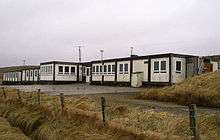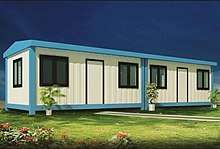Portable building
A portable, demountable or transportable building is a building designed and built to be movable rather than permanently located.

Portable buildings are generally manufactured using sustainable and eco friendly materials.
Smaller version of portable buildings are also known as portable cabins. Portable cabins are custom built prefab structures manufactured for variety of applications such as site office, security cabin, accommodation, storage, toilets etc. Portable cabins are an affordable alternative to traditional buildings, and of course, they offer a flexible solution where accommodation is required for an uncertain period of time.
From formal office accommodation to comfortable eating and relaxation areas, toilet and shower facilities to site security units portable cabins are fast to manufacture and easy to deliver.
A common modern design is sometimes called a modular building, but portable buildings can be different in that they are more often used temporarily and taken away later. Portable buildings (e.g. yurts) have been used since prehistoric times.[1]
Many modern types of portable buildings are designed so that they can be carried to or from the site on a large lorry and slung on and off by a crane.
Modern usage
.jpg)
The first portable building under the trade name Portakabin was developed in 1961 in York (UK) by Donald Shepherd.[2]
Portable modular buildings have various uses. They are often seen, alone or in groups, as temporary site offices on building sites (where they are often stacked two high with metal stairs to reach the upper level; see also Construction trailer). Other uses for these and other types of portable buildings are as guard shacks, in-plant offices (these are typically portable steel buildings), rural offices, on-site changing rooms, etc. Some portable buildings can be made very complex by joining units and forming large office blocks over several floors. These are often disguised as a normal building with brick style cladding and a traditional pitched roof. Tara Park, developed by Liverpool City Council, have even used portable buildings to create temporary/permanent domestic housing for communities. Still complying with UK building regulations and disabled access.
Due to population increases in many areas, portable buildings are sometimes brought in to schools to provide relief from overcrowding. Portable classroom buildings often include two classrooms separated by a partition wall and a toilet. Portable buildings can also serve as a portable car garage[3] or a storage unit for larger items. Businesses will often utilize portable buildings for bulk storage or construction equipment.

Alternative names
In Australia, small portable accommodation buildings are often called dongas.[4] In Australia the word "demountable" in particular refers to portable classrooms.
In the United Kingdom the words "Portakabin", "Portacabin", "Bunkabin" and "terrapin" are commonly used to describe these buildings. However, the use of these words as generic descriptions of portable buildings has caused contention amongst some manufacturers.
The "Portakabin" spelling with a 'k' is a trademark owned by Shepherd Building Group's Portakabin Ltd[5] to identify its range of relocatable and modular buildings but is often used as a generic trademark to mean any portable building of that general pattern. The spelling with a 'c' normally refers to similar temporary buildings made by other companies; Portakabin Ltd argues that the spelling "portacabin" is a misspelling.
"Terrapin" like Portakabin, is a portable building manufacturer, although the term "terrapin building" is often used to describe any modular or prefabricated building.[6] The use of “terrapin” dates back further than “Portakabin or “Portacabin” as the company has been trading for over 60 years. The phrase “terrapin classroom”[7] arose from the sudden need for additional classroom space following the post-World War II baby boom era, and is now common usage for any portable classroom.
In Canada, Australia, and elsewhere, portable buildings are sometimes referred to as "ATCO huts," after the Canadian energy company that manufactures a line of them in one of its business units.[8]
See also
References
- Houses in Motion: The Genesis, History and Development of the Portable Building by Robert H. Kronenburg ISBN 978-1-85490-395-2
- Glancey, Jonathan (3 April 1997). "Obituary: Donald Shepherd". The Independent. Retrieved 3 June 2019.
- "Portable Garages – When On Earth Media". When On Earth. 2019-10-26. Retrieved 2019-12-09.
- Terzon, Emilia (23 September 2016). "Origin of the word donga 'a bit of a mystery' to Australian linguists". Australian Broadcasting Corporation.
- "Case details for Trade Mark 851268". UK Intellectual Property Office. 18 July 2008.
- "The Patents and Designs Journal" (PDF). UK Intellectual Property Office. 17 July 2002. Archived from the original (PDF) on 16 June 2012. Retrieved 17 June 2011.
- "Gloucestershire Victoria County History 'Painswick: Education', A History of the County of Gloucester: Volume 11: Bisley and Longtree Hundreds, pp. 85-86". Gloucestershire County History Trust. 1976.
- "Canadian Energy Group ATCO Limited Backs Beach Petroleum Limited's Shale Gas Foray In Cooper Basin" (Press release). Beach Energy. 8 December 2009. Retrieved 21 January 2013.
.jpg)